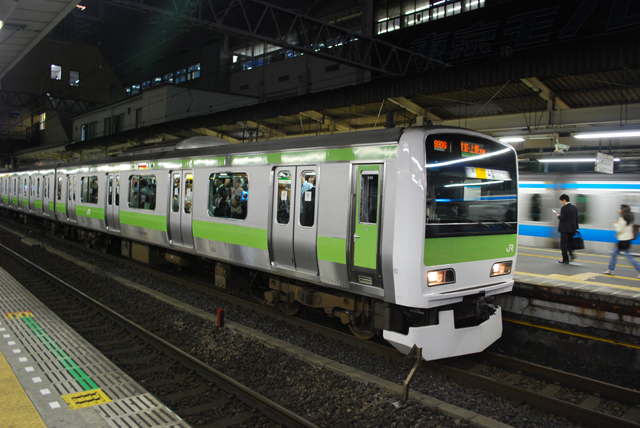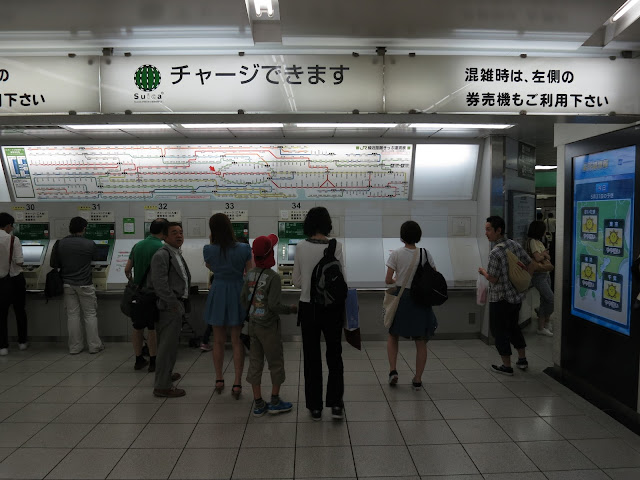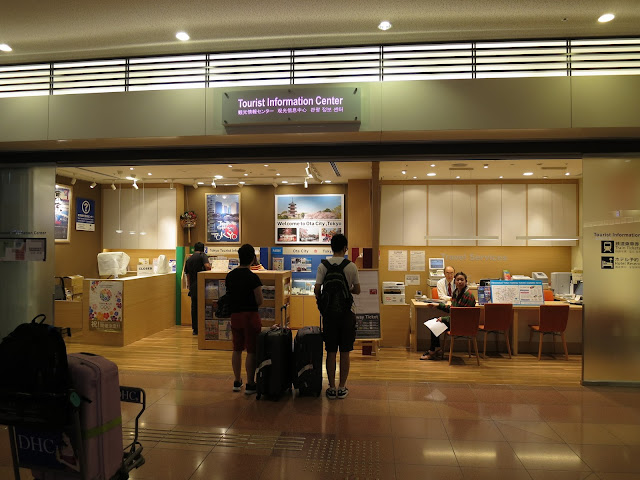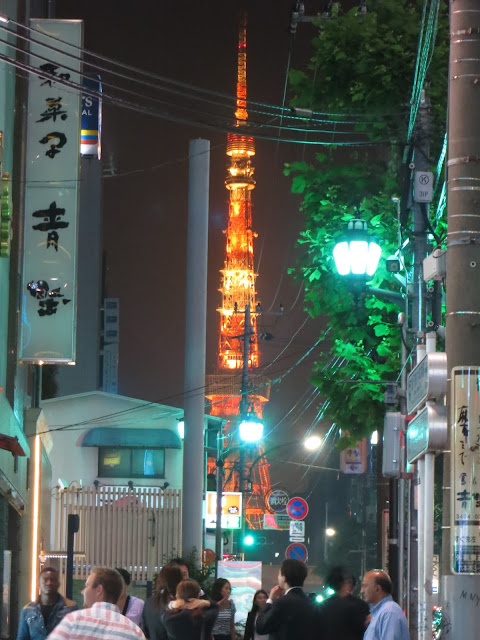 |
| Famous Tokyo Yamanote loop line train |
-To read about my recommendations of affordable, reasonable, convenient hotels in Tokyo, visit Affordable Cheap Reasonable Hotels in Tokyo.
-To read about my recommendations of best food in Tokyo, visit Best food in Tokyo Japan.
-To read about the best way to exchange your money, visit Money Exchange ATM credit card issue in Tokyo Japan.
-To read about where you can find the best Ramen in Tokyo, visit Best Ramen in Tokyo.
 |
| Some trains offer very pleasant train ride in assigned seats |
I recommend readers to first familiarize themselves with my previous blog post "Tokyo Orientation" before reading this blog post.
It would also be helpful if you have a JR or Subway map to look at while you are reading this blog post. I have provided links to the maps on the bottom of this blog post.
Buying Tickets
All Tokyo train and subway tickets can be bought through using the automatic ticket vending machine located at every station. There will always be an English language button on the screen for oversea visitors to navigate through. Tickets could also be bought through the ticket office at major train/subway stations, but station staff will often tell you to go to the vending machine for purchasing.
 |
| Vending machine selling tickets or SUICA/PASMO card |
- When purchasing individual tickets, first look at the train fare map at each station, pick the fare for your destination, then go up to the vending machine for purchasing. First press the English button (if you do not read Japanese language) then pick the number of ticket(people) then pick the fare. The grand total of cost will be shown on the machine. Insert bills or coins as payments, the machine will only accept bills and coins as forms of payment.
 |
| English button on the top right corner |
 |
| Look for the fare written under your destination on the train map |
SUICA and PASMO card
I personally use a SUICA card for my travel within the Tokyo area. This type of cards are basically prepaid or IC (integrated circuit) card, which you deposit a certain amount of money in it and the cost of transportation are automatically deducted when exiting the station.
 |
| A must-have in Tokyo - SUICA card |
- When using SUICA or PASMO card, just hold your card close to the ticket gate sensor when you are going through the gate, the cost will be automatically deducted from your card deposit. When there is insufficient funds in the card, the gate will not open, it will require you add more funds by inserting the cards into the vending machine.
 |
| Automated ticket gate in every train or subway station |
Train/Subway Day pass
Several types of day pass are available for the ease of tourism; Some of the passes are only available for oversea visitors and require you to show your passport at the time of purchase. Some passes are only sold at the airports upon arrival in Japan. The benefit of day passes is that the cost of transportation are all covered during the day, travelers can afford to getting lost or wondering around in the city; the disadvantage is that you are sometimes limited to the coverage of specific transportation system. Overall, I would say subway systems cover quite extensively throughout the Tokyo area.
Day pass type and availability vary frequently, I am providing links to official sites of different systems in Tokyo.
Tokyo Metropolitan District Pass (Tokunai Pass)
Tokyo Tour Ticket (Tokyo Furii Kippu)
Yokohama-Minatomirai Pass
Tokyo Metro 1-day Open Ticket
Toei One-Day Economy Pass
Tokyo Metro Special Combination Multiple Day Pass
 |
| Ask about train or subway day passes at airport tourist information centers |
Tokyo Major Transportation Systems
Japan Railway train (JR)
 |
| Experience Tokyo like a real Tokyoite by riding the commuter train |
Yamanote Line
Perhaps the most important train route in Tokyo. Yamanote line runs in a loop that encircles what is generally being considered "central Tokyo." The loop route runs both clockwise and counterclockwise. Almost all the train stations on the Yamanote line are connected with other JR lines or subway stations. Because of its convenience, I will always give new travelers the recommendation of staying at a hotel within 5 minute walk from a JR station on the Yamanote line. I would also recommend new travelers to avoid taking the Yamanote line during rush hours because of the extremely high ridership.
Clockwise (I have listed all the stations on Yamanote line due to its importance in Tokyo travel)
- Shinagawa - Osaki - Gotanda - Meguro - Ebisu - Shibuya - Harajuku - Yoyogi - Shinujuku -Shin-Okubo - Takadanobaba - Mejiro - Ikebukero - Otsuka - Sugamo - Komagome - Tabata - Nishi-Nippori - Nippori - Uguisudani - Ueno - Okachimachi - Akihabara - Kanda - Tokyo -Yurakucho - Shimbashi - Hamamatsucho - Tamachi
Important JR Yamanote line stations to remember
- Shinagawa: Gateway to central Tokyo from Haneda airport and bullet train station when visiting west of Tokyo area. Connection include Narita Express and JR Keihin-Tohoku Line.
- Shibuya: Famous scramble crossing and night life district; Connection include Tokyo Metro Ginza line, Hanzomon line, and Fukutoshin line.
- Harajuku: Meiji Jingu shrine; connecting at the nearby Meiji Jingumae station of the Tokyo Metro Chiyoda line.
- Shinjuku: Main hub of subway and private train; Connections including JR Chuo Rapid, Chuo main, Saikyo, Narita Express, Tokyo Metro Marunouchi line, Toei Shinjuku line, and many private train lines.
- Ikebukuro: Bustling area similar to Shinjuku; connection include Tokyo Metro Marunouchi, Yurakucho and Fukutoshin lines.
- Ueno: Gateway to central Tokyo from Narita airport and bullet train station when visiting North/East of Tokyo area; Famous Ameyokocho shopping area with street food vendors; Connection include Keisei Skyliner from Narita airport, Tokyo Metro Ginza and Hibiya lines.
- Akihabara: Anime, pop culture and electronics central; connection include JR Chuo-Sobu and Keishin Tohoku lines; Tokyo Metro Hibiya line; and Tsukuba Express.
- Tokyo: Near the Imperial palace; Tokyo station holds its historical importance. Tokyo Ramen street underground. Connection include Bullet train station when visiting North/East of Tokyo area; Tokyo Metro Marunouchi line.
- Shimbashi: Gateway to the Odaiba area via Yurikamome line; Connection include JR Keihin-Tohoku line, Tokyo metro Ginza and Toei Asakusa line.
- Hamamatsucho: Gateway to central Tokyo from Haneda airport via Tokyo monorail; Nearest JR station to the Tokyo Tower; Connection include JR Keihin-Tohoku line, Toei Asakusa. Close proximity to Daimon station of the Toei Oedo line.
Chuo Line (Rapid)
Connecting from JR Tokyo station to JR Shinjuku station in the central Tokyo and going west bound to the popular Nakano and Kichijoji areas. Cutting across the central Yamanote loop line in the middle.
Chuo Line (Local)
Similar to Chuo Line rapid; Cutting across the central Yamanote loop line in the middle. Connecting through JR Akihabara, Yoyogi and Shinjuku stations.
Keihin Tohoku Line
Connecting from Yokohama to the south and Omiya to the north of Tokyo. Major connection in Tokyo include JR Shinagawa, Tokyo, Akihabara, and Ueno stations.
Saikyo Line
Connection from Tokyo JR Osaki station to JR Omiya station in Saitama area, passing through JR Shibuya, Shinjuku and Ikebukuro stations.
 |
| Signs are well labeled in English at major train/subway stations in Tokyo |
 |
| Platform information are also well labeled in English at major train/subway stations in Tokyo |
Tokyo Metro and popular Tokyo Metro stations to be noted
- Ginza Line: Starting from Shibuya and ends at Asakusa; connecting through JR Shimbashi, JR Ueno, Tokyo Metro Ginza and Toei Asakusa stations.
- Marunouchi Line: starting from Ogikubo and ends at Ikebukuro station; connecting through Tokyo Metro Shinjuku, Tokyo, and Korakuen stations.
- Hibiya Line: Starting from Naka-Meguro and ends at Kita-Senju; connecting through Toei Roppongi, Tokyo Metro Ginza, Tokyo Metro Tsukiji, JR Akihabara, and JR Ueno stations.
- Tozai Line: Starting from Nakano and ends at Nishi Funabashi; connecting through JR Takadanobaba, Waseda, Kagurazaka, and Nihombashi stations.
- Chiyoda Line: Starting from Yoyogi-Uehara and ends at Ayase; connecting through Tokyo Metro Meiji-Jingumae, Akasaka, and Nijubashimae stations
- Yurakucho Line: Starting from Wakoshi and ends at Shin-Kiba stations; connecting through JR Ikebukuro, Tokyo Metro Yurakucho, Ginza-itchome, Tsukishima stations.
- Hanzomon Line: Starting from Shibuya and ends at Oshiage stations; connecting through Tokyo Metro Omotesando, Aoyama-itchome, and Mitsukoshimae stations.
- Namboku Line: Starting from Meguro and ends at Akabane-Iwabuchi stations; connecting through Tokyo Metro Roppong-itchome, Iidabashi and Korakuen stations.
- Fukutoshin Line: Starting from Wakoshi and ends at Shibuya station; connecting through Tokyo Metro Meiji-Jingumae, Higashi-Shinjuku, Ikebukuro stations.
Toei Subway and popular Toei stations to be noted
 |
| Best ground level view of Tokyo Tower can be seen from Roppongi; Roppongi can be reached by subway |
- Asakusa Line: Starting from Nishi-Magome and ends at Oshiage; connecting through Toei Daimon, JR Shimbashi, Toei Asakusabashi, and Toei Asakusa stations.
- Mita Line: Starting from Meguro and ends at Nishi Takashimadaira station; connecting through Toei Shibakoen, Tokyo Metro Hibiya, JR Suidobashi stations, and JR Sugamo stations.
- Shinjuku Line: Starting from Shinjuku and ends at Moto-Yawata station; connecting through Tokyo Metro Kudanshita, Jimbocho, and Toei Bakuro-Yokoyama stations.
- Oedo Line: Starting from Tochomae and ends at Hikarigaoka ; connecting through Tokyo Metro Shinjuku-Nishiguchi, Higashi-Shinjuku, Tsukishima, Roppongi, Toei Daimon, and Toei Tsukijishijo stations.
Bus
Tokyo has an extensive bus system and I would not recommend new travelers to take the bus due to its complexity. JR train and subway systems will likely to cover majority of the sightseeing spots and point of interests.
Taxi
Sure you can taxi to visit sightseeing spots, but taxi fare is very expensive in Tokyo and other parts of Japan; therefore, I would recommend saving your taxi money and explore Tokyo like other Tokyoite. Taxi is only feasible when you have more than one person split the fare with, or if you have young kids in your group.
Driving/Rental Car
I would probably never recommend driving rentals cars in Tokyo, mainly due to hectic traffic, unfamiliar driving rules and very expensive parking fees.
Useful links
Japan Railway Maps and Guides
Tokyo Metro Subway Map
TOEI Subway Map

No comments:
Post a Comment